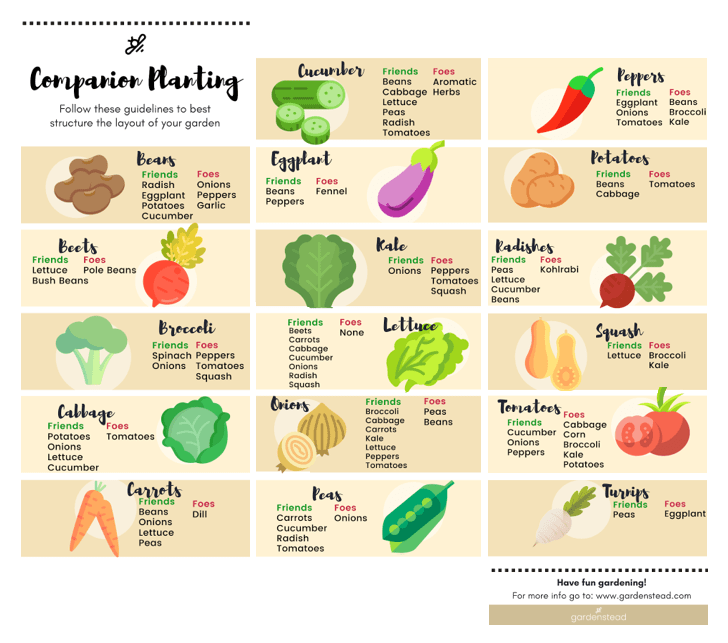In this article, we’ll explore the topic of companion planting and discuss the dos and don’ts of vegetable combinations. We’ll delve into the world of off-grid living and gardening to give you more context about the subject. Additionally, we’ll provide insights on which vegetables should not be planted next to each other. So sit back, relax, and get ready to learn all about creating harmonious vegetable gardens.
Companion planting: The dos and don’ts of vegetable combinations
Companion planting is a gardening technique that involves planting certain plants together to maximize their growth and productivity. By selecting the right combinations of vegetables, herbs, and flowers, you can create a harmonious garden ecosystem that benefits both the plants and the gardener. In this article, we will explore the concept of companion planting, its benefits, and the factors to consider when choosing companion plants.
Understanding the concept of companion planting
Companion planting is based on the idea that some plants have natural affinities for each other, while others may hinder each other’s growth. By strategically pairing compatible plants, you can enhance their health, flavor, and resistance to pests and diseases. The practice of companion planting has been used for centuries by gardeners around the world, and it continues to gain popularity due to its numerous benefits.
The benefits of companion planting
One of the main advantages of companion planting is its ability to promote healthier and more abundant crops. Certain plant combinations enhance each other’s growth by providing shade, support, or nutrient sharing. For example, tall plants like corn or sunflowers can provide much-needed shade to delicate lettuce or spinach. Similarly, vine plants like beans or cucumbers can climb up trellises provided by taller plants, maximizing space utilization.
Companion planting also improves pest and disease management. By selecting plants that naturally repel pests, you can reduce the need for chemical pesticides. For instance, planting aromatic herbs like basil and rosemary alongside vegetables can deter aphids and other common pests. Additionally, some flowers attract beneficial insects like bees and ladybugs, which provide natural pest control by preying on harmful insects.
Factors to consider when choosing companion plants
When selecting companion plants, it is essential to consider several factors to ensure successful pairings. First, consider the growth habits and space requirements of each plant. Avoid planting aggressive or spreading plants together, as they may compete for resources and overshadow each other. Instead, opt for combinations that allow each plant to thrive without overcrowding.
Another factor to consider is the nutritional needs of plants. Some plants are heavy feeders and deplete the soil of specific nutrients. Pairing them with plants that have different nutritional requirements can help prevent nutrient deficiencies and maintain soil fertility. For example, planting nitrogen-fixing legumes like peas or beans alongside leafy greens can enrich the soil with nitrogen, promoting healthy growth.
Furthermore, consider the compatibility of plants based on their pests and diseases. Certain plants are more susceptible to specific pests or diseases, and planting them together may increase the risk of infestation or spread. To prevent this, choose companion plants that have different vulnerability profiles, reducing the chance of widespread damage.
Complementary plant pairings
Now that we understand the concept and benefits of companion planting, let’s explore some examples of plant combinations that enhance growth, flavor, and pest control.
Plant combinations that enhance growth and flavor
Certain plant combinations have been found to enhance the growth and flavor of vegetables. For instance, pairing tomatoes with basil has long been practiced due to their mutual benefits. The scent of basil helps repel tomato hornworms and enhances the flavor of tomatoes. Similarly, planting radishes alongside carrots can improve the flavor of both vegetables, as the radish leaves break up the soil and provide a loose structure for the carrots to grow.
Using aromatic herbs to repel pests
Aromatic herbs are highly effective at repelling pests and can be strategically planted alongside vegetables to provide natural pest control. For example, planting mint or chives near cabbage and broccoli can help deter cabbage worms, while marigolds planted near tomatoes can repel nematodes and whiteflies. The strong scents of these herbs act as a natural deterrent, reducing the need for chemical pesticides.
Creating shade or support with taller plants
Taller plants can serve as living supports or provide shade for smaller and more delicate vegetables. For instance, planting corn or sunflowers alongside lettuce or spinach can provide much-needed shade during hot summer months. Additionally, tall plants like beans or peas can be trained to climb up trellises provided by taller plants, maximizing vertical space in the garden.
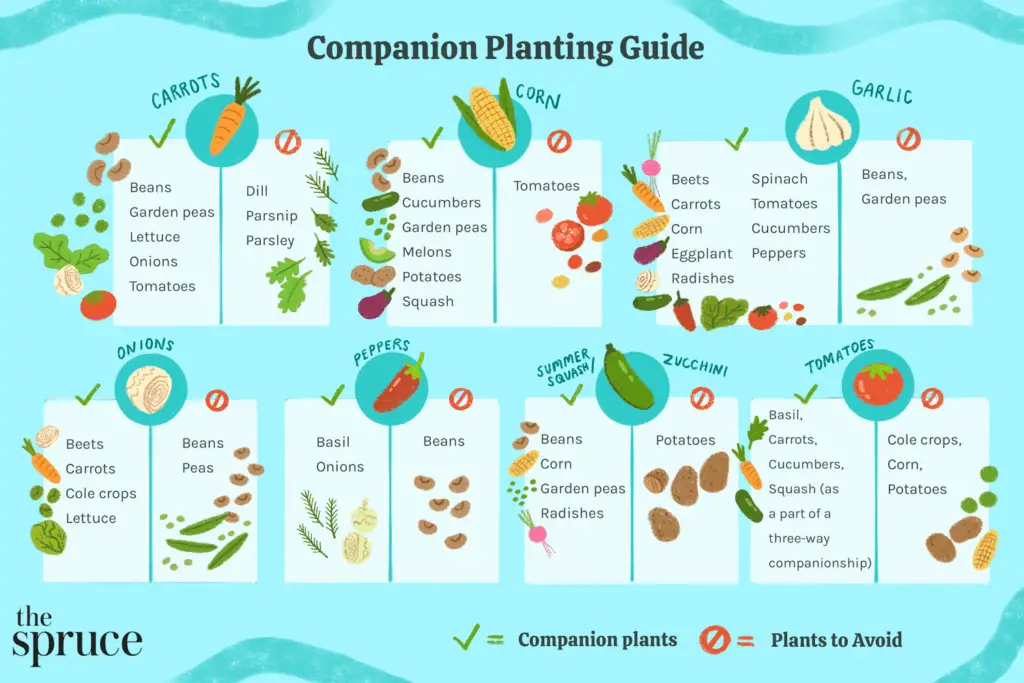
Avoiding incompatible plant combinations
While companion planting offers numerous benefits, it is crucial to avoid certain plant combinations that can hinder each other’s growth or increase the risk of pests and diseases.
Plants that compete for resources
Some plants are known to compete for resources like nutrients, water, and sunlight. Planting incompatible combinations may result in stunted growth or overcrowding. For instance, planting potatoes and tomatoes together is not recommended, as they are both heavy feeders and may exhaust the soil of essential nutrients. Similarly, avoid planting onions or garlic near beans, as they may inhibit the bean plants’ growth.
Suppressive or allelopathic plant interactions
Certain plants produce compounds that inhibit the growth of other plants, a phenomenon known as allelopathy. It is important to avoid planting incompatible combinations to prevent allelopathic effects. For example, planting members of the brassica family, such as cabbage or broccoli, near strawberries can impede the strawberries’ growth due to the release of allelopathic compounds.
Plants with similar pest or disease vulnerabilities
Plants that are susceptible to the same pests or diseases should not be planted together, as this increases the risk of widespread infestation or outbreak. For instance, planting tomatoes near potatoes can increase the chances of blight affecting both plants. Similarly, avoid planting cucumbers near melons, as they are both prone to cucumber beetles and powdery mildew.
Combating pests and diseases through companion planting
Companion planting is an effective strategy for managing pests and diseases in the garden. Here are some methods to attract beneficial insects, repel pests, and use trap crops to divert pests away from desirable plants.
Attracting beneficial insects to control pests
Many beneficial insects, such as ladybugs and lacewings, feed on harmful pests like aphids and caterpillars. By planting flowers that attract these beneficial insects, you can create a natural balance in your garden. Some flowers that attract beneficial insects include marigolds, calendula, and alyssum. Be sure to include these flowers in your companion planting scheme to promote a healthy ecosystem.
Repelling pests with specific plant choices
Certain plants naturally repel pests due to their scent or chemical properties. For instance, planting garlic alongside roses can repel aphids, while catnip planted near brassica crops can deter cabbage moths. Incorporating these pest-repellent plants in your garden can help reduce the need for chemical pesticides and create a more environmentally friendly growing environment.
Using trap crops to divert pests away from desirable plants
Trap crops are plants that are specifically grown to attract pests away from more desirable plants. By sacrificing these trap crops, you can protect your valuable vegetables from infestation. For example, planting sunflowers near cucumbers can attract cucumber beetles, diverting them away from the cucumbers. Be sure to monitor and remove the trap crops as soon as pest activity is observed to prevent the pests from spreading.

Companion plants for popular vegetables
Now let’s explore some specific examples of popular vegetables and their ideal companions and enemies in companion planting.
Tomatoes: Ideal companions and enemies
Tomatoes have several ideal companions, including basil, marigolds, and onions. Basil improves the flavor of tomatoes and repels pests like hornworms, while marigolds deter nematodes and whiteflies. Onions provide protection against beetles and aphids. However, tomatoes should not be planted near potatoes or members of the brassica family, as they can increase the risk of diseases like blight.
Carrots: Beneficial plant associations
Carrots benefit from being planted alongside onions, leeks, and chives. These aromatic plants repel carrot flies and other pests that can damage the carrot crop. Conversely, carrots should not be planted near dill or parsnips, as they may cross-pollinate and affect the flavor and quality of the carrots.
Lettuce: Compatible and incompatible plant pairings
Lettuce grows well with companions like radishes, carrots, and herbs like parsley and dill. Radishes help break up the soil and prevent soil-borne diseases, while carrots offer shade and protection against pests. Herbs like parsley and dill attract beneficial insects that prey on lettuce pests. Avoid planting lettuce near members of the brassica family, such as cabbage or broccoli, as they may compete for resources and increase the risk of disease.
Utilizing flowers in companion planting
Flowers play a vital role in companion planting by attracting pollinators and offering natural pest protection. Here are some ways to utilize flowers in your companion planting scheme.
Flowers that attract pollinators to aid vegetable production
Many vegetables depend on pollinators like bees and butterflies for successful fruit set. By planting flowers that attract these pollinators, you can increase the yield and quality of your vegetable crops. Some pollinator-friendly flowers include lavender, zinnias, and borage. Be sure to intersperse these flowers throughout your vegetable garden to provide a food source for the pollinators.
Decorative flowers that offer pest protection
Certain ornamental flowers also provide natural pest protection in the garden. For example, planting nasturtiums near squash or cucumbers can deter squash bugs and aphids. Marigolds are also effective at repelling nematodes and other soil-borne pests. Incorporate these colorful flowers into your garden beds and borders to add beauty and functionality to your landscape.
Floral intercropping for improved biodiversity
Intercropping refers to the practice of growing different plant species together in close proximity. By intercropping flowers with vegetables, you can increase biodiversity and create a more resilient garden ecosystem. The diverse range of plants attracts a wider variety of beneficial insects and promotes a balance of pests and predators. Consider planting flowers like cosmos, sunflowers, or daisies among your vegetable crops to maximize biodiversity.
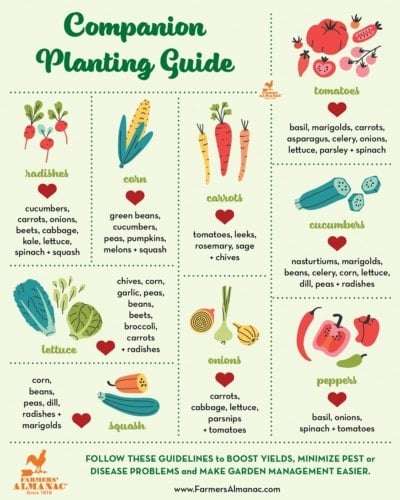
The role of herbs in companion planting
Herbs offer a multitude of benefits in companion planting, including natural pest-repellent properties and attracting beneficial insects. Here are some ways to utilize herbs in your companion planting strategy.
Herbs with natural pest-repellent properties
Many herbs possess natural pest-repellent properties and can be strategically planted alongside vegetables to deter common pests. For example, planting thyme near cabbage can help repel cabbage worms, while rosemary planted near carrots can deter carrot flies. Incorporate these herbs in your garden to provide a natural defense against pests.
Herbs that attract beneficial insects
Certain herbs are known for attracting beneficial insects like bees, butterflies, and predatory insects. Planting these herbs near your vegetable crops can help increase pollination rates and provide natural pest control. For instance, planting lavender or borage near tomatoes can attract bees, improving fruit set and production. Be sure to include these beneficial insect magnets in your companion planting scheme.
Herbal combinations for improved flavor and growth
Herbs can also improve the flavor and growth of vegetables when planted together. For example, planting basil near tomatoes enhances their flavor and repels pests, while planting mint near cabbage can improve the cabbage’s taste. Explore different herbal combinations to discover unique flavor profiles and promote healthier growth in your vegetable garden.
Understanding the concept of allelopathy
Allelopathy is a phenomenon that occurs when certain plants release chemical compounds that inhibit the growth of neighboring plants. It is important to understand the concept of allelopathy when planning your companion planting scheme to avoid incompatible combinations.
The chemical interactions between plants
Allelopathy occurs through the release of chemical compounds known as allelochemicals. These chemicals can be present in different parts of the plant, including the leaves, roots, or fruits. When released into the environment, allelochemicals can affect the germination, growth, or development of nearby plants through various mechanisms.
Common allelopathic plants and their effects
Several common plants are known for their allelopathic effects on neighboring plants. For example, black walnut trees release a compound called juglone, which inhibits the growth of many plants, including tomatoes, potatoes, and peppers. Similarly, members of the sunflower family, such as sunflowers and marigolds, produce allelochemicals that can suppress the growth of certain plants.
Using allelopathy in companion planting
While allelopathy can be detrimental in certain situations, it can also be harnessed for beneficial purposes in companion planting. For example, planting allelopathic cover crops like rye or buckwheat can help suppress weeds and improve soil health. By selecting appropriate allelopathic plant combinations, you can utilize this phenomenon to your advantage in the garden.
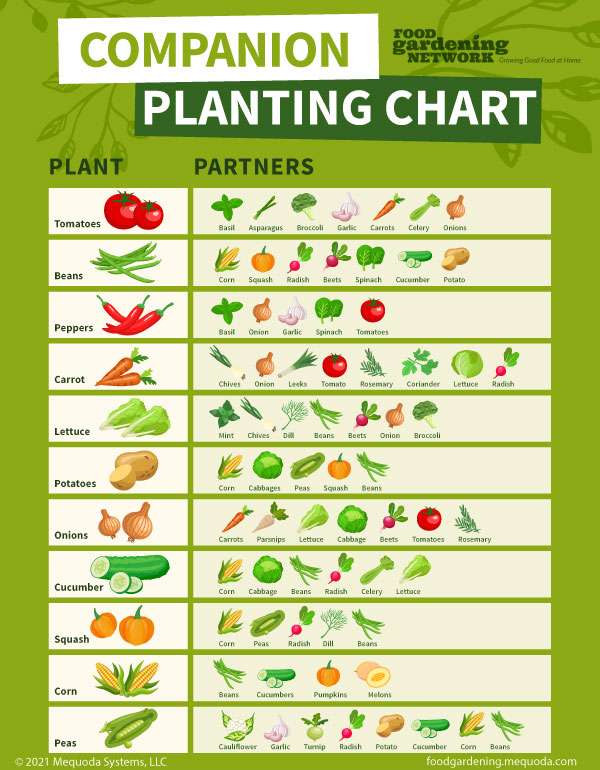
Companion planting in small spaces
Companion planting is not limited to large gardens. It can also be successfully implemented in small spaces, such as balconies, patios, or rooftop gardens. Here are some strategies for companion planting in small spaces.
Vertical gardening with compatible plant combinations
Vertical gardening is an excellent way to maximize space utilization in small gardens. By pairing compatible plants, you can create a productive and visually appealing vertical garden. For example, consider growing tomatoes alongside basil or nasturtiums in a vertical planter. The tomatoes provide support for the taller basil or trailing nasturtiums, while the herbs or flowers help repel pests and improve the flavor of the tomatoes.
Container gardening and suitable companion plants
Container gardening is ideal for small spaces, as it allows you to grow plants in limited areas like pots or raised beds. When selecting plants for container gardening, choose companion plants that have similar growing requirements and compatible root systems. For example, you can grow lettuce alongside radishes or herbs like chives and parsley in a container. These combinations not only save space but also complement each other in terms of growth and flavor.
Maximizing small garden areas through effective companions
In a small garden area, every square inch matters. By utilizing effective companion plantings, you can maximize the space available and increase overall productivity. For example, consider interplanting fast-maturing vegetables like radishes or lettuce between rows of slower-growing crops like tomatoes or peppers. This way, you can harvest quick-yielding crops while waiting for the main crops to mature, making the most of your limited garden space.
Implementing crop rotation with companion planting
Crop rotation is an essential practice in vegetable gardening that helps prevent soil-borne diseases and maintain soil fertility. By combining crop rotation with companion planting, you can further enhance the health and productivity of your garden.
The importance of crop rotation in vegetable gardens
Crop rotation involves the systematic movement of different plant families within the garden over multiple growing seasons. This practice breaks disease cycles, improves soil structure, and reduces pest populations. By rotating crops annually, you can minimize the risk of nutrient deficiencies and ensure long-term garden health.
Incorporating companion planting in crop rotation plans
When planning your crop rotation, consider the companion planting aspect to create synergistic combinations. For example, after growing nitrogen-fixing legumes like beans, peas, or clover, follow with a heavy-feeding crop like corn or tomatoes. The legumes enrich the soil with nitrogen, which benefits the subsequent crop. Similarly, intercropping with pest-repellent herbs or flowers can provide natural protection for vulnerable crops in each rotation cycle.
Benefits of combining both strategies
Combining crop rotation with companion planting offers several benefits. It helps prevent the buildup of pests and diseases, promotes balanced nutrient cycling, and optimizes space utilization. The diversified plantings created through both strategies create a healthier and more sustainable garden ecosystem, leading to higher yields and improved plant health.
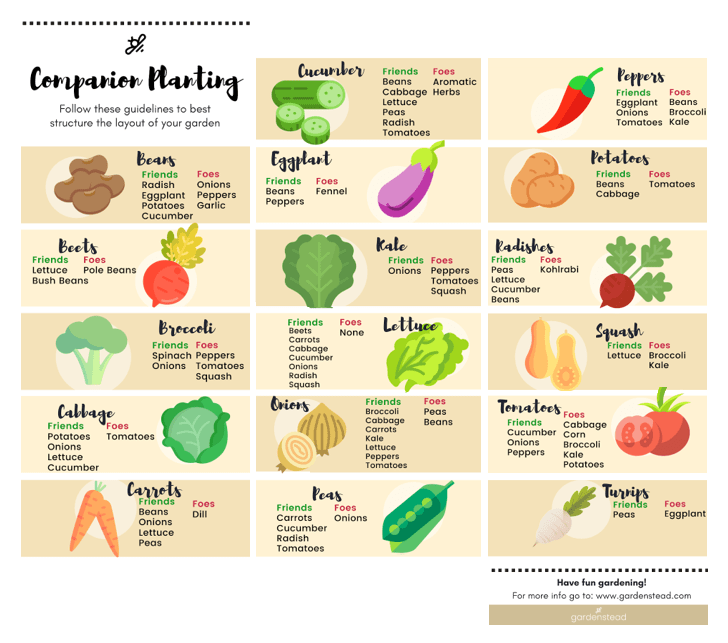
Potential challenges and troubleshooting
Despite the many benefits of companion planting, there can be some challenges and issues that may arise. Here are some common challenges and troubleshooting tips to address them.
Identifying and rectifying imbalances in plant partnerships
In some cases, the desired benefits of companion planting may not be fully realized, indicating an imbalance in plant partnerships. For instance, if pest infestation persists despite companion planting, it may be necessary to reassess the selection of companion plants or explore alternative pest control methods. Regular monitoring and observation can help identify and rectify imbalances in plant partnerships.
Addressing overly aggressive companion plants
Some companion plants can become overly aggressive and overpower neighboring plants, leading to stunted growth and reduced productivity. To address this, it is important to select companion plants that have similar growth habits and are not excessively competitive. Additionally, regular pruning and maintenance can help contain the growth of aggressive companion plants and prevent them from overpowering others.
Dealing with unexpected disease or pest outbreaks
Despite best efforts, unforeseen disease or pest outbreaks can occur in the garden. In such cases, it is crucial to take prompt action to minimize the damage. Remove and destroy infected or infested plants, and consider implementing targeted pest control measures such as neem oil or insecticidal soaps. Regularly inspecting plants for signs of diseases or pests and maintaining good garden hygiene can help prevent and address outbreaks.
Research-based evidence on companion planting
Companion planting is a widely practiced gardening technique, but it is always important to evaluate the scientific evidence supporting its effectiveness. While anecdotal evidence and traditional knowledge have their value, scientific studies can provide valuable insights into the benefits and limitations of companion planting.
Scientific studies supporting the effectiveness of companion planting
Numerous scientific studies have confirmed the benefits of companion planting in various contexts. Research has shown that certain plant combinations can enhance growth, improve pest and disease resistance, and increase overall crop productivity. By reviewing the findings of these studies, gardeners can make more informed decisions when planning their companion planting schemes.
Evaluating the reliability of companion planting claims
While scientific evidence supports many claims about companion planting, it is essential to evaluate the reliability of specific claims. Some recommendations may be based on limited evidence or may not hold true in certain environments or with specific plant varieties. To ensure the success of your companion planting, it is important to consider not only the scientific evidence but also your local climate, soil conditions, and specific gardening circumstances.
Practical application and adapting scientific findings
While scientific studies provide valuable insights, practical application is key to successful companion planting. Gardeners should consider their own observations, experiences, and local gardening practices when implementing companion planting techniques. It is also important to adapt scientific findings to suit individual gardening situations, as what works in one garden may not necessarily work in another.
Success stories and testimonials
Many gardeners have experienced tremendous success with companion planting, both in small-scale gardens and on a larger agricultural level. Here are some inspiring success stories and testimonials showcasing the effectiveness of companion planting.
Gardeners’ experiences with successful companion planting
Countless gardeners have shared their experiences of successful companion planting. They have witnessed healthier plants, increased crop yields, and improved pest and disease management through strategic plant combinations. These success stories highlight the achievable benefits and encourage other gardeners to explore companion planting in their own gardens.
Notable examples of companion planting in agriculture
Companion planting techniques are not limited to small-scale gardening; they can also be applied on a larger agricultural scale. Several notable examples of companion planting in agriculture include intercropping corn with beans to maximize space utilization and nutrient cycling, and growing flowers alongside cash crops to attract pollinators and beneficial insects. These examples demonstrate the versatility and scalability of companion planting practices.
Finding inspiration from real-life success stories
Real-life success stories can provide inspiration and guidance for those interested in companion planting. Whether it’s a local community garden or a large-scale organic farm, learning from the experiences of others can help gardeners adapt companion planting techniques to their own unique situations. By incorporating successful strategies and adapting them to their own gardens, gardeners can increase the likelihood of achieving similar successes.
Conclusion
Companion planting is a valuable technique that can greatly enhance the health and productivity of your vegetable garden. By selecting suitable plant combinations, you can promote healthier growth, repel pests, and improve flavor. Consider the dos and don’ts of companion planting, and carefully evaluate the compatibility and benefits of different plant combinations. Remember that companion planting is a dynamic practice that requires adaptation and experimentation. By harnessing the power of companion planting, you can create a thriving garden ecosystem and achieve successful vegetable gardening. So, start exploring the world of companion planting and unleash the potential of your garden!

